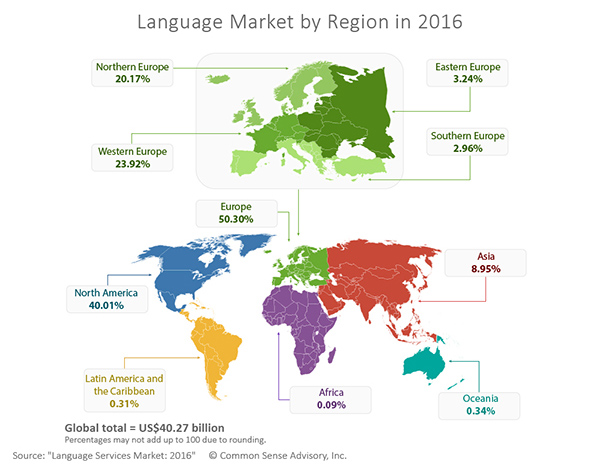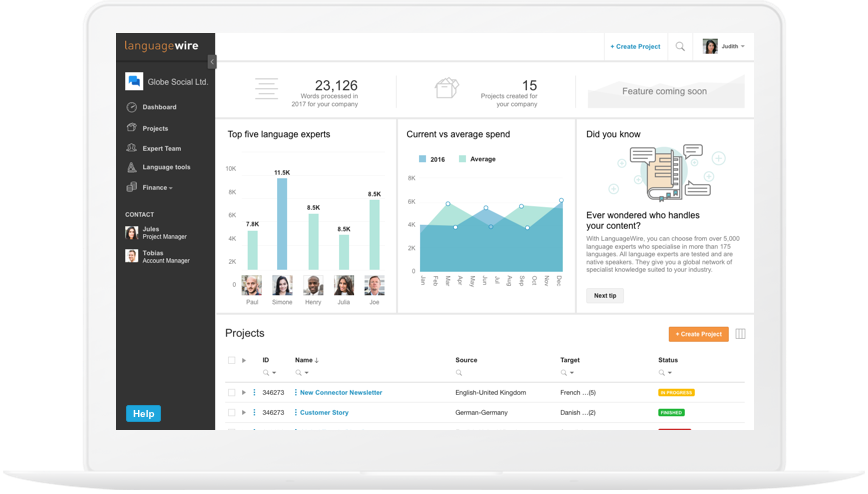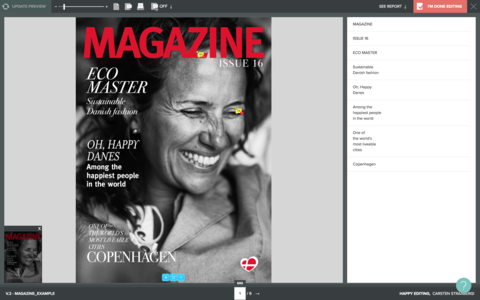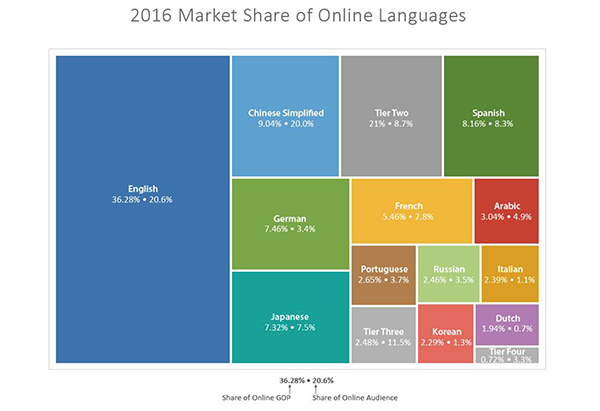You’ll need to work with the facts if you want to do things in an optimal way. Well, unless you’re one of the lucky few who can get by without them, that is. The business rationale is that it’s all about the bottom line, and a common measurement of this is Return of Investment, also known as ROI. In this blog post we’ll help you take a fact-based approach towards the benefits of creating multilingual content. But first, let’s briefly look at the reasons why.
The need for multilingual content
Brands are creating more content in order to reach a larger audience; 76% of B2B marketers and 77% of B2C marketers say they will produce more content in 2016 compared to 2015 according to the Content Marketing Institute. They’re also translating and localising this content in increasing numbers, which is reflected in the 5.52% growth in the language services industry from 2015 to 2016.

“The global market for outsourced language services and technology will reach US$40.27 billion in 2016” — Common Sense Advisory
The benefits of providing a multilingual experience is backed up by research. More than half of the respondents to a study of consumers based in non-English speaking countries stated that they rarely or never do their online shopping on English-language sites. In a separate study, it was found that more than 4 out of 5 business buyers are more likely to buy a product with online information in their language.
So the importance of speaking the right language is clear, since your customers obviously have a better experience when you communicate with them in their native tongue. But budgets are limited and you’ll want to invest in multilingual content with maximum impact. Taking that into consideration, let’s have a look at how ROI can be measured for your translations.
Measuring ROI
A vast majority of brands treat translation and localisation as a cost centre, but we think this is viewpoint is too limited, and that it rather should be seen as an economic opportunity. Backing up that statement, a 2013 survey by Common Sense Advisory found that over a third of respondents’ firms spent US$1 million or more annually on localisation, but that only 1 out of 4 tracked their ROI.

In its simplest form, ROI is the net gain from the investment (gain minus cost) divided by the cost of investment. So what’s the best way to measure ROI for translation? First, you need to define your return.
1. Define Your Return
Your return depends on what your business goals are and how you measure success. In its narrowest definition, ROI is the ratio of your net profit to the relevant costs. But depending on your strategy, you may be more interested in factors such as the number of new customers, their total visiting time online, conversion rates, your market share or simply traffic volumes to your website.
If you’re a seller of physical products, you can define your return as what you make from selling those products. But if you’re interested in leads, your revenue is the amount you make on a typical lead. It becomes more complicated when you consider cross-border differences such as spending power and purchasing behaviour, but the economic opportunity of different languages is something we’ll delve deeper into later on.
2. Measure Your Investment
Translation investments are usually measured in terms of cost per word, so measuring this basic variable shouldn’t be very difficult. It is usually calculated as the number of translated words multiplied by the cost per word. There may also be fixed costs from the translation software you use, but these are also relatively simple to incorporate.
The tricky part is measuring the coordination costs. These vary dramatically depending on the ability of your translation partner. If you are translating internally via e-mail and without a Translation Memory, Termbase or other computer aided translation (CAT) tools, then you are operating inefficiently according to today’s standards. Any time spent managing translations will eat into the time of your copywriters, project managers, webmasters, digital marketers and any other zany job titles out there.
Additionally, you will have to invest in other areas than translation to gain the full benefits of new markets. Customer support is vital, and a local sales team will unlock further regional potential. With that being said, this is where it makes sense to talk about how you can maximise the return on your translation investment.
Improve your translation ROI
So what are the proven ways of improving the ROI calculation for translation work? You’ll want the right technology that reduces manual work and centralises processes. You’ll also want to identify and invest in the languages where your business stands to gain the most.
Translation Management
A good translation management system (TMS) will automate much of the translation process. This is the engine that will let you work more efficiently, yielding higher quality output. Instead of sending out translation projects via e-mail and then manually hunting for the correct file or piece of correspondence, everything is collected in one place in the cloud. The key benefits of a good TMS is efficiency, access to a network of professional translators, the ability to easily keep track of projects and costs, collaborative tools for keeping everyone on the same page and, of course, scalability.
The LanguageWire Collaboration Platform offers all of these benefits and more. This tool acts as a facilitator, connecting brands to a global network of language experts as well as the best project managers and file engineers in the industry. When you manage your translation projects in LanguageWire, the multi-faceted platform brings together various modules, resulting in greater translation ROI. Let’s take a look at some of those modules.
Translation Memories and Translation Databases

CAT (Computer-assisted translation) tools, like the ones integrated with the LanguageWire platform, improve efficiency and performance
Wouldn’t it be great to not have to pay for translating the same text twice? This is one of the benefits with translation memories (TM). TMs are a standard piece of technology used during translation, and they benefit businesses and translators alike. Whenever a translation is made, the TM stores the translation in segments so that it easily can be recalled when similar content is being worked on. The TM monitors translations in the editor where translations are made, and notifies the translator when a similar segment is found in the memory so that the previous translation can be used. Not only does this saves time and money, but it also ensures a consistent brand tone.
A translation database, sometimes called a Termbase, acts as a glossary. It contains pre-approved terms specific to a brand. A good translation memory prompts the translator when a standardised term is spotted, offering the correct translation immediately. This also aids consistency and makes translation easier.
In short, a TM acts as a dynamic database of translated content while the Termbase is a glossary unique to your brand. Both of them improve the quality of multilingual content, save time and reduce translation costs, which improves ROI in the long term.
Collaboration in InDesign

With WeAllEdit, multiple users can simultaneously edit InDesign documents in WYSIWYG format
LanguageWire has developed a hugely beneficial tool called WeAllEdit, which allows multiple people to collaborate in InDesign. With this tool, you can access InDesign files uploaded to the cloud and comment on and edit them without needing to get a graphic designer involved or even install InDesign.
It’s a massive help when proofreading, but it can also be used for other purposes such as giving feedback on layout and quickly updating copy in InDesign documents. Danske Bank uses WeAllEdit and saved 1,500 hours in its first year of working with it. Novo Nordisk saved massive amounts of time as well; an impressive 15% of their total time spent on desktop publishing. When working with InDesign documents, the benefits of having such a tool are clear.
Working with The Best People in The Best Possible Way

Another proven way of improving ROI is to work with the best people available, preferably on an innovative platform. Here at LanguageWire we have improved our translation quality by streamlining the way we collaborate with preferred language experts on specific projects, which improves the overall quality immensely. Since our handpicked experts work continuously on the same projects, they get to know the brand and its communication style, resulting in higher quality translations. It also helps to have a good dialogue system in place to aid communication with the team and track projects easily. Having all necessary information and for the project in one place makes your work life a lot easier, and since all communication is streamlined you won’t have to worry about missing deliveries when you’re approaching the deadline.
Choosing the Right Languages
With translation technology removing much of the administrative overhead, adding additional languages becomes a lot easier. But even though the marginal cost per language diminishes, it’s still important to prioritise language investments. Many brands only use two or three languages for communication. However, research by LanguageWire has shown that larger companies make their website available in six languages on average. But is this enough? As more people are connected to the internet, major languages are capturing less and less of the global market share. According to Common Sense Advisory, it took 12 languages to reach 80% of people on the internet in 2007. This increased to 14 languages in 2015.
But is it enough to look at the share of the global audience? The economic opportunity of each language is a more relevant measurement for businesses when making strategic decisions. Common Sense Advisory takes GDP, population and internet penetration rates into account when calculating these numbers. According to this measurement, just 14 languages account for 90% of the global digital opportunity as of 2016.

Source: Digital Opportunity: Top 100 Online Languages for 2016 — Common Sense Advisory
To improve ROI, CSA recommends a tiered approach where businesses group several languages together and have varying localisation depth. As you can see in the image above, there are 12 tier 1 languages, which together account for 88.5% of the digital opportunity in 2016. Ben Sargent described this in a recent article in Brand Quarterly: “Tier 1 languages reflect their largest markets deserving a full complement of product lines, informational content, and marketing campaigns. Tier 2 markets get a smaller collection of content and campaigns, while tier 3 language sites display a minimum footprint of static information such as corporate contact information”.
But it’s also important to keep in mind the opportunity for long-tail growth. English, German, French, Italian, Dutch and Korean take a disproportionate share of the economic opportunity based on the audience size. The assumption could be drawn that these languages’ share will drop the most as the rest of the world catches up in online economic terms. So it can be good to also consider the long term potential of languages when prioritising language investment.
One piece of the puzzle
Don’t forget that ROI is just one way to measure success. Trying to identify all the variables in play can become quite complex, and the actual effort may overshadow any benefits provided. When looking at investment returns over time, please consider the Net Present Value (NPV) when comparing investments.
The result becomes more accurate the more variables you add, but the calculation also becomes a lot harder. So invest in this calculation depending on your resources at hand. The most important thing is to focus on your needs and where you can gain greater efficiencies by choosing the right languages, the right tools and the right translation partner.

